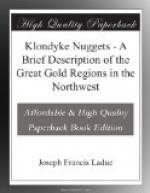“No streams of any importance enter any of these lakes so far as I know. A river, called by Schwatka “McClintock River,” enters Marsh Lake at the lower end from the east. It occupies a large valley, as seen from the westerly side of the lake, but the stream is apparently unimportant. Another small stream, apparently only a creek, enters the south-east angle of the lake. It is not probable that any stream coming from the east side of the lake is of importance, as the strip of country between the Lewes and Teslintoo is not more than thirty or forty miles in width at this point.
“The Taku Arm of Tagish Lake, is, so far, with the exception of reports from Indians, unknown; but it is equally improbable that any river of importance enters it, as it is so near the source of the waters flowing northwards. However, this is a question that can only be decided by a proper exploration. The canon I have already described and will only add that it is five-eighths of a mile long, about 100 feet wide, with perpendicular banks of basaltic rock from 60 to 100 feet high.
“Below the canon proper there is a stretch of rapids for about a mile; then about half a mile of smooth water, following which are the White Horse Rapids, which are three-eighths of a mile long, and unsafe for boats.
“The total fall in the canon and succeeding rapids was measured and found to be 32 feet. Were it ever necessary to make this part of the river navigable it will be no easy task to overcome the obstacles at this point; but a tram or railway could, with very little difficulty, be constructed along the east side of the river past the canon.
“For some distance below the White Horse Rapids the current is swift and the river wide, with many gravel bars. The reach between these rapids and Lake Labarge, a distance of twenty-seven and a half miles, is all smooth water, with a strong current. The average width is about 150 yards. There is no impediment to navigation other than the swift current, and this is no stronger than on the lower part of the river, which is already navigated; nor is it worse than on the Saskatchewan and Red Rivers in the more eastern part of our territory.
“About midway in this stretch the Tahkeena River[5] joins the Lewes. This river is, apparently, about half the size of the latter. Its waters are muddy, indicating the passage through a clayey district. I got some indefinite information about this river, from an Indian who happened to meet me just below its mouth, but I could not readily make him understand me, and his replies were a compound of Chinook, Tagish, and signs, and therefore largely unintelligible. From what I could understand with any certainty, the river was easy to descend, there being no bad rapids, and it came out of a lake much larger than any I had yet passed.
[Footnote 5: The Tahkeena was formerly much used by the Chilkat Indians as a means of reaching the interior, but never by the miners owing to the distance from the sea to its head.]




